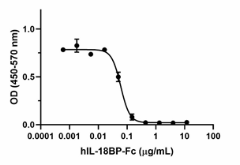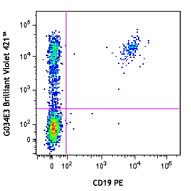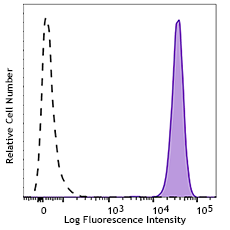- Regulatory Status
- RUO
- Other Names
- Interleukin 18 Binding Protein, MC51L-53L-54L Homolog Gene Product, Tadekinig-Alfa
- Ave. Rating
- Submit a Review
- Product Citations
- publications

-

Recombinant human IL-18BP-Fc chimera inhibits the activity of recombinant human IL-18 (Cat. No. 592102) at 18.75 ng/mL to induce IFN-γ production by KG-1a cells. The ED50 for this effect is 0.025 – 0.125 µg/mL. -

Stability Testing for Recombinant Human IL-18BP-Fc Chimera. Recombinant human IL-18BP-Fc chimera was aliquoted in PBS, pH7 at 0.2 mg/mL. One aliquot was frozen and thawed four times (4x Freeze/Thaw) and compared to the control that was kept at 4⁰C (Control). The samples were tested for their ability to inhibit recombinant human IL-18 (Cat. No. 592102, at 18.75 ng/mL) activity to promote production of IFN-γ in KG-1a cells. The ED50 for this effect is 0.025 – 0.125 µg/mL.
Select size of product is eligible for a 40% discount! Promotion valid until December 31, 2024. Exclusions apply. To view full promotion terms and conditions or to contact your local BioLegend representative to receive a quote, visit our webpage.
IL-18 binding protein (IL-18BP) binds to IL-18 with high affinity (Kd = 400 pM), neutralizes IL-18 activity and binds to IL-18 in a stoichiometric ratio. IL-18 belongs to the Interleukin-1 family and is a potent inflammatory cytokine. IL-18 is secreted by macrophages and dendritic cells and is expressed constitutively even in the absence of an inflammatory stimulus. IL-18 induces IFN-γ production, in the presence of IL-12 or IL-15, from Th1 cells. In addition, IL-18 promotes FasL-mediated cytotoxicity by NK cells. IL-18 has been associated with inflammatory and autoimmune diseases such as emphysema, metabolic syndromes, inflammatory bowel disease, and sepsis among others. IL-37 also interacts with IL-18BP at limiting concentrations of IL-18BP and at a 50- to 100-fold molar excess of IL-37. This interaction increases the inhibitory effect of IL-18BP on IL-18-induced IFN-γ in an NK cell line. IL-18 and IL-18BP are elevated in patients with eczema; also, IL-18 and IL-18BP are high in serum of patients with chronic liver disease. In addition, patients with heart failure have shown increases in IL-18 but decreases in IL-18BP levels. Currently, IL-18BP is in a clinical trial for the treatment of Adult-onset Still’s disease, an inflammatory disease, which is characterized by high levels of IL-18 in plasma.
Product DetailsProduct Details
- Source
- Human IL-18BP, amino acid (Thr31-Gly194) (Accession: # O95998), with a C-terminal SR-IEGRMD-hIgG1-Fc tag was expressed in CHO cells.
- Molecular Mass
- The 403 amino acid recombinant protein has a predicted molecular mass of approximately 44.5 kD. The DTT-reduced and non-reduced protein migrates at approximately 65 and 120 kD by SDS-PAGE respectively. The predicted N-terminal amino acid is Thr.
- Purity
- > 95%, as determined by Coomassie stained SDS-PAGE
- Formulation
- 0.22 µm filtered protein solution is in PBS.
- Endotoxin Level
- Less than 0.1 EU per µg cytokine as determined by the LAL method
- Concentration
- 10 and 25 µg sizes are bottled at 200 µg/mL. 100 µg size and larger sizes are lot-specific and bottled at the concentration indicated on the vial. To obtain lot-specific concentration and expiration, please enter the lot number in our Certificate of Analysis online tool.
- Storage & Handling
- Unopened vial can be stored between 2°C and 8°C for up to 2 weeks at -20°C for up to six months, or at -70°C or colder until the expiration date. For maximum results, quick spin vial prior to opening. The protein can be aliquoted and stored at -20°C or colder. Stock solutions can also be prepared at 50 - 100 µg/mL in appropriate sterile buffer, carrier protein such as 0.2 - 1% BSA or HSA can be added when preparing the stock solution. Aliquots can be stored between 2°C and 8°C for up to one week and stored at -20°C or colder for up to 3 months. Avoid repeated freeze/thaw cycles.
- Activity
- Recombinant human IL-18BP-Fc chimera inhibits the activity of recombinant human IL-18 (Cat. No. 592102) at 18.75 ng/mL to induce IFN-γ production by KG-1a cells. The ED50 for this effect is 0.025 – 0.125 µg/mL.
- Application
-
Bioassay
- Application Notes
-
BioLegend carrier-free recombinant proteins provided in liquid format are shipped on blue-ice. Our comparison testing data indicates that when handled and stored as recommended, the liquid format has equal or better stability and shelf-life compared to commercially available lyophilized proteins after reconstitution. Our liquid proteins are validated in-house to maintain activity after shipping on blue ice and are backed by our 100% satisfaction guarantee. If you have any concerns, contact us at tech@biolegend.com.
Antigen Details
- Structure
- Dimer
- Distribution
-
Mononuclear cells, leukocytes, keratinocytes, dermal fibroblasts. IFN-γ induces IL-18BP in colon carcinoma cells, ovarian epitheleal cancer cells, HepG2 cells, HaCaT keratinocyte, and fibroblast-like synovial cells.
- Function
- Downregulates Th1 responses by binding to IL-18. The nuclear transcription factor LXR, IL-27, and IFN-γ regulate the expression of IL-18BP. IL-12 induces IL-18BP in monocytes via IFN-γ.
- Interaction
- IL-37
- Ligand/Receptor
- IL-18
- Bioactivity
- IL-18BP inhibits the activity of IL-18.
- Antigen References
-
1. Paulukat J, et al. 2001. J. Immunol 167:7038.
2. Veenstra KG, et al. 2002. J. Immunology 168:2282.
3. Bufler P, et al. 2002. Proc. Natl. Acad. Sci. USA. 99:13723.
4. Mallat Z, et al. 2004. FASEB 18:1752.
5. Wittmann M, et al. 2012. PLoS One. 7(6):e38751.
6. Dinarello CA, et al. 2013. Front Immunol. 4:289.
7. Carbotti G, et al. 2013. Clin. Cancer Res. 19:4611.
8. Pourcet B, et al. 2016. Sci Rep. 6:25481.
9. Hu Y, et al. 2017. Mediators Inflamm. 2017:3090782.
10. Harms RZ, et al. 2017. Front Immunol. 8:1020. - Gene ID
- 10068 View all products for this Gene ID
- UniProt
- View information about IL-18BP on UniProt.org
Related Pages & Pathways
Pages
Related FAQs
- Why choose BioLegend recombinant proteins?
-
• Each lot of product is quality-tested for bioactivity as indicated on the data sheet.
• Greater than 95% Purity or higher, tested on every lot of product.
• 100% Satisfaction Guarantee for quality performance, stability, and consistency.
• Ready-to-use liquid format saves time and reduces challenges associated with reconstitution.
• Bulk and customization available. Contact us.
• Learn more about our Recombinant Proteins. - How does the activity of your recombinant proteins compare to competitors?
-
We quality control each and every lot of recombinant protein. Not only do we check its bioactivity, but we also compare it against other commercially available recombinant proteins. We make sure each recombinant protein’s activity is at least as good as or better than the competition’s. In order to provide you with the best possible product, we ensure that our testing process is rigorous and thorough. If you’re curious and eager to make the switch to BioLegend recombinants, contact your sales representative today!
- What is the specific activity or ED50 of my recombinant protein?
-
The specific activity range of the protein is indicated on the product datasheets. Because the exact activity values on a per unit basis can largely fluctuate depending on a number of factors, including the nature of the assay, cell density, age of cells/passage number, culture media used, and end user technique, the specific activity is best defined as a range and we guarantee the specific activity of all our lots will be within the range indicated on the datasheet. Please note this only applies to recombinants labeled for use in bioassays. ELISA standard recombinant proteins are not recommended for bioassay usage as they are not tested for these applications.
- Have your recombinants been tested for stability?
-
Our testing shows that the recombinant proteins are able to withstand room temperature for a week without losing activity. In addition the recombinant proteins were also found to withstand four cycles of freeze and thaw without losing activity.
- Does specific activity of a recombinant protein vary between lots?
-
Specific activity will vary for each lot and for the type of experiment that is done to validate it, but all passed lots will have activity within the established ED50 range for the product and we guarantee that our products will have lot-to-lot consistency. Please conduct an experiment-specific validation to find the optimal ED50 for your system.
- How do you convert activity as an ED50 in ng/ml to a specific activity in Units/mg?
-
Use formula Specific activity (Units/mg) = 10^6/ ED50 (ng/mL)
 Login / Register
Login / Register 












Follow Us